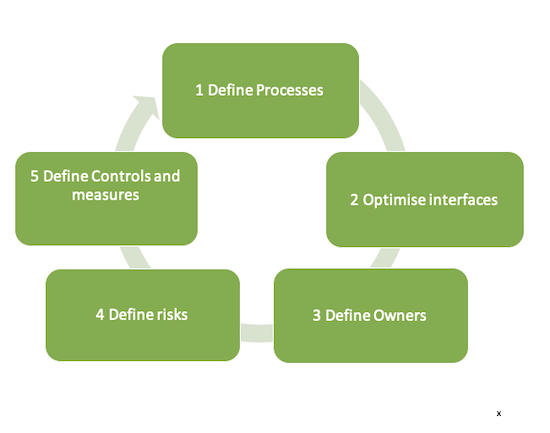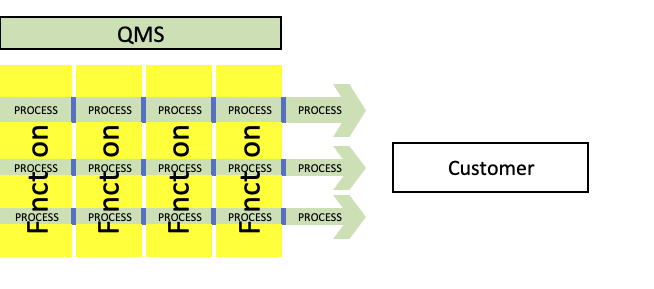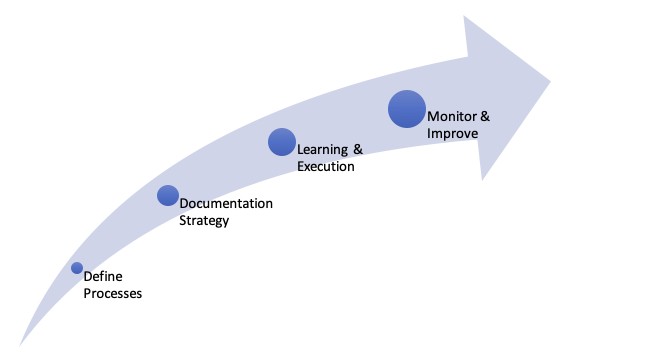A Process Management Framework is a management system that is constructed from a hierarchy of documents and processes spanning end-to-end activities in support of customer requirements and deliverables.
Process management frameworks are an alternative to silo-based, functional management systems.
The methodology focuses on optimizing interconnecting processes that span the organization and operators of those processes to attain high levels of quality and compliance with customer needs.
In today’s article, we’ll be covering Process Management Frameworks; we’ll be taking a look at the following:
- What is a process Management Framework
- Process Management Framework key characteristics
- Processes in a Process Management Framework
- Documentation in a Process Management Framework
- Key concepts of a Process Management Framework
- Why use a Process Management Framework
- Monitoring Process Management Frameworks
- Benefits of a Process Management Framework
- Issues with a process management Framework
What is a process management framework?
A business utilizes its management system to drive activities that deliver value and compliance and achieve goals.
To be effective, a management system requires to be :
- Clear and easy to execute
- Has appropriate associated documentation
- Is simple to train against, empowering employees
- Has a consistent approach and definition across the business
- Meets both regulatory and customer needs
In a functional-based management system, recognizing that no one function produces the end output for a customer, the focus is on functional excellence (including optimizing functional processes, controls and measures).

While a functional approach offers some levels of effectiveness, functions may have contrasting objectives, and interfaces between functions may not be optimized.
A key challenge through this approach is that no single view of the customer across the organization is represented.
In order to solve this, we can utilize a process management framework which is constructed to focus on how processes join together across the whole organization in order to deliver customer value.
Process Management Framework key characteristics
A process management framework has several characteristics.
- Focused on end-to-end processes that span an organization
- Aligns management system and documents to these end-to-end processes
- Is customer and compliance-focused
- Aligns goals and objectives to be organizational rather than functional
- Assesses and mitigates process risk
- Endeavours to optimize the interfaces between processes (including where they span functions)
- Optimizes learning to optimize process execution
- Determines processes that demand control documentation which helps record how activities are undertaken and drive compliance
- Has measures which are customer-focused (quality and compliance)
- Determines the health of processes within the management review process.

While functional (or silo-based) management systems offer a convenient approach to Quality Management, the result is that all too often, success is measured against functional plans and goals.
Process frameworks offer a richer alternative to a more functional-driven approach where the focus shifts from functional competency to customer value created through end-to-end process excellence.
With the goal of accommodating the whole of the organization, frameworks can be structured in such a way that processes are designed to mitigate gaps between processes and duplication (which is often prevalent in areas where processes interface).
While functions remain important (they own the necessary skills and competencies to carry out the processes), process management frameworks reinforce the sustainment of customer goals and deliverables, offering an efficient method of managing processes reducing the administrative burden and reducing management costs.
Processes in a process management framework
The key behind a process framework is the recognition that products and services are delivered by processes.
Thus, a central pre-requisite is that an organization must be prepared to clearly understand how processes interact with one and other across the length of the business in order to deliver customer value.
Many organizations will find themselves needing to map this using appropriate tools. Many will find challenges through this process e.g.
- Not all needed processes are represented
- Issues emerge where processes overlap
- There is duplication in activities (often within functions)
- Controlled documentation does not match with the actual requirement
- Employees/Process operators understand the functional value but not customer value and how it is created.
Once understood, processes can then be optimized).
While functions remain important for many businesses adopting a process management framework requires a cultural shift.
Businesses adopting process management frameworks will recognize the required transformative journey which will need to be embarked upon to deliver the required change.
Documentation and end-to-end processes
The management of controlled documentation and information remains vital; this includes necessary processes associated with the activity.
Issues can sometimes arise as historical information and documentation may not be aligned with implemented frameworks.
This can be challenging. However, this process needs to remain wedded to the concept of end-to-end process for the framework to succeed.
Examples of the controlled documentation that will be included in this hierarchy include:
- Quality manuals
- Work Instructions
- Standard Operating Procedures
- Policies
Many organizations will define and implement a new document hierarchy that is aligned with end-to-end processes.
The downside is this may necessitate the revision of existing documentation, requiring resource/cost.
Uniting staff with controlled documentation information remains essential. Quality functions and business leadership will be required to develop appropriate mechanisms in order to facilitate this.
Key concepts of a Process Management Framework?

A typical framework consists of four main components/phases.
1/ Defining processes
As we’ve described, the construction of appropriate processes that establish an end-to-end view focused on providing quality to the customer is essential.
Process mapping and process engineering may be required in order to facilitate this (especially where processes are functional and entrenched).
Characteristics of this phase include
- Definition of the end-to-end landscape of processes that deliver value to the customer (can be done through tools like value stream mapping). This is likely to consider processes that have a major impact on the customer, together with ancillary processes and controls.
- Defines process owners
- Determine risks
- Identify process controls and measures.
2/ Determine documentation strategy
As we’ve described, the documentation strategy is dependent on process, quality characteristics and objectives, risk, and customer impact.
This phase may necessitate the definition of a new documentation hierarchy prioritizing documentation aligned to key control processes.
The importance of communication should be recognized, especially where significant change has occurred, remembering that it is a key enabler to the release of documentation.
We also need to understand the purpose of our documentation set in the first place. Generally two-fold:
- Compliance
- Capturing a record of how an organization does business through policies, procedures etc.
Finally, it’s essential that our documentation set supports our end-to-end view of the business rather than being merely functionally focused.
The stage has several characteristics:
- Processes that have controlled documentation requirements are identified
- Information that drives performance is defined (with owners)
- A documentation hierarchy is established
- Communication is planned and executed
- Training needs relating to documentation are established.
3/ Learning and Execution
It’s not enough to have great processes. Even the best processes are worthless if the user isn’t trained in how to carry them out effectively.
Effective training is a whole article in itself, so we won’t dwell too deeply. However, we will point out some effective training characteristics:
- Train the right processes (Don’t train what you won’t use)
- Be clear on Responsibilities
- Give your users as much practical experience in executing the process as you can
- Where you include artefacts (i.e. documents), make them credible to the process being trained
- Consider how you will implement process change within your training regime
- Avoid overloading your students
- Align the timing of training to process execution in order to get the best returns.
4/ Monitor and improve
Whatever approach to your management system you employ, there will be a need to measure performance and to have an appropriate management review cycle.
By developing a Process management framework, we are going to focus on the QMS but with a particular stance on the end-to-end process; this should include:
- Managing process change
- Having a clear management review process
- Reviewing and managing process health
- Measuring performance
- Measuring compliance
Why use a Process Management Framework
Functional-based management systems are not inherently wrong, but they are often misaligned with customer needs. They look at functional excellence and functional goals.
Process Management Frameworks target a form of organizational excellence and achieve organizational goals by aligning with customer needs and goals.
The rationale for adopting a framework approach is that:
- An organization becomes acutely aware of how it builds value,
- We focus on the hand-offs between processes to ensure effectiveness (which would be lost in a silo-based approach)
- Focus is given to critical areas
- Focus on data and information required by the end-to-end processes
- Through a focus on critical processes, we are better able to focus on and reduce risk.
Monitoring Process Management Frameworks

Monitoring process management frameworks utilize metrics and data much like any other system.
Metrics within such systems critically focus on output that is important to the customer.
Monitoring in a framework environment focuses on several key aspects:
- Critical to quality (against customer)
- Agreed targets
- Ownership of the metric
- Risk (reducing and improving detectability)
- Performance in hand-off areas
- Ensuring the output matches customer requirements
Benefits of a Process Management Framework
As we’ve described, there are numerous benefits to this approach; these include:
- Increased customer value
- Increased accountability through a focus on processes and process owners
- Compliance, through a focus on requirements and customer goals
- Reduction in risk
- Performance in line with customer needs
- Aligned goals and objectives through all functional areas within an organization
- A clear understanding of how process change will impact the customer
- Reduction in conflicting functional objectives (as business switches to an end-to-end view)
Issues with a process management Framework
As with any system, there are some issues to watch out for; these include:
- Careful implementation planning may be required in legacy businesses with existing (and perhaps conflicting) documentation
- Requires a cultural shift in the whole organization that requires leadership support.
- It may not be an overnight process
- Requires organizational engagement and participation
- Existing documentation may become misaligned with end-to-end process strategy
- Ineffective communication and training (on process execution) may hamper progress
Summary
As we’ve described, the process management framework can be seen as a central element of an effective Quality Management System.
Through its implementation, critical processes associated with adding value to the customer become clearly identified and prioritized. As a result, the organization focuses on effective enablers such as documentation, training and change.
While there are some common enablers, a process management framework has clear differences from a more functional-based management system.
As such, it represents a significant change for some businesses that shouldn’t underestimate the process to follow in successfully implementing it.
Has your business utilized this approach with its management system?
If so, we’d love to hear your feedback. As ever, you can reach out to us on Twitter or via the comments section below.
